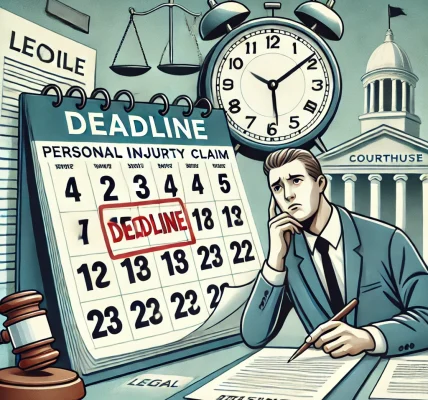When you suffer an injury due to someone else’s negligence, you may be entitled to compensation. However, the law imposes strict deadlines for filing a lawsuit, known as the statute of limitations. Understanding how the statute of limitations applies to personal injury cases is crucial to ensuring you don’t lose your right to seek justice.
In this article, we’ll explain what the statute of limitations is, how it varies by state, exceptions that may extend or shorten the deadline, and what happens if you miss the filing deadline.
What is the Statute of Limitations in a Personal Injury Case?
The statute of limitations is a legal time limit within which a plaintiff must file a lawsuit against the responsible party. Once this period expires, the injured party generally loses the right to seek compensation through the courts.
Why Do Statutes of Limitations Exist?
Statutes of limitations serve several purposes, including:
- Preserving evidence – Over time, evidence may be lost, and witnesses may forget crucial details.
- Encouraging timely legal action – Prompt filings help ensure fair proceedings.
- Providing legal certainty – Defendants should not face indefinite liability for past events.
Statute of Limitations for Personal Injury Cases by State
The time limit for filing a personal injury lawsuit varies depending on the state where the injury occurred. Below are some examples of common statute of limitations periods in different states:
| State | Statute of Limitations |
|---|---|
| California | 2 years |
| Texas | 2 years |
| New York | 3 years |
| Florida | 4 years |
| Illinois | 2 years |
| Georgia | 2 years |
| Pennsylvania | 2 years |
Important: Always check the latest laws in your state, as statutes of limitations can change over time.
When Does the Statute of Limitations Start?
The statute of limitations clock typically starts ticking from the date of the injury. However, in some cases, the start date may vary based on legal doctrines such as:
1. Discovery Rule
If an injury is not immediately apparent, the statute of limitations may start when the victim discovers (or should have discovered) the injury.
Example: A patient undergoes surgery but later discovers that a surgical instrument was left inside their body. The statute of limitations may begin when the object is discovered rather than on the date of the surgery.
2. Delayed Symptoms
Certain injuries, such as exposure to toxic substances, may not show symptoms until years later. In such cases, courts may apply the discovery rule to allow a later filing date.
3. Minor or Mentally Incapacitated Victims
If the injured party is a minor or legally incapacitated, the statute of limitations may be paused (tolled) until they turn 18 or regain mental capacity.
4. Defendant Leaves the State
If the defendant leaves the state after causing the injury but before a lawsuit is filed, the statute of limitations may pause until they return.
Exceptions That May Shorten the Statute of Limitations
In some cases, the statute of limitations may be shorter than expected. Some examples include:
1. Government Claims
If the responsible party is a government agency, the filing deadline is often much shorter. Many states require victims to file a notice of claim within 6 months to 1 year before pursuing a lawsuit.
Example: In California, claims against a government agency must be filed within 6 months of the injury.
2. Contractual Agreements
Some businesses or organizations may have contracts that limit how long a person has to file a claim.
3. Medical Malpractice Caps
Certain medical malpractice laws impose caps on how long a person can sue, even if injuries are discovered later.
What Happens If You Miss the Statute of Limitations Deadline?
If you attempt to file a personal injury lawsuit after the statute of limitations has expired, the defendant can file a motion to dismiss, and the court will likely reject your case.
However, there are some exceptions:
- If you qualify for tolling provisions (such as the discovery rule or being a minor), you may still have a chance to file.
- In rare cases, a judge may grant an equitable exception if strict application of the law would cause extreme injustice.
How to Protect Your Right to File a Lawsuit
To ensure you don’t miss your chance to seek compensation, follow these important steps:
1. Seek Medical Attention Immediately
Documenting your injuries with medical records helps strengthen your case.
2. Consult a Personal Injury Attorney
An experienced lawyer can determine the applicable statute of limitations and any exceptions that may apply.
3. Gather and Preserve Evidence
Keeping records of medical bills, accident reports, photos, and witness statements can help support your claim.
4. Act Quickly
Waiting too long to take legal action can result in losing critical evidence or missing the filing deadline altogether.
Conclusion
Understanding the statute of limitations is essential for anyone considering a personal injury lawsuit. Filing within the deadline ensures you preserve your legal rights and increase your chances of obtaining compensation. Since laws vary by state and case circumstances, consulting a personal injury attorney as soon as possible is the best way to ensure compliance with legal deadlines.
If you or a loved one has suffered an injury due to negligence, don’t wait—seek legal advice immediately to protect your rights.




